Tesla Motors Five Forces Analysis and PESTEL Report
VerifiedAdded on 2020/09/17
|14
|3451
|117
AI Summary
The report presents a thorough examination of Tesla Motors' competitive landscape, industry dynamics, and external factors influencing the company's operations. A detailed five forces analysis is conducted to identify the intensity of competition, threat of substitutes, bargaining power of suppliers and buyers, and threat of new entrants. The PESTEL evaluation assesses the impact of political, economic, social, technological, environmental, and legal factors on Tesla Motors' business strategy. The report aims to inform strategic decision-making for the company, highlighting key recommendations for strengthening its competitive advantage through innovation and market presence.
Contribute Materials
Your contribution can guide someone’s learning journey. Share your
documents today.
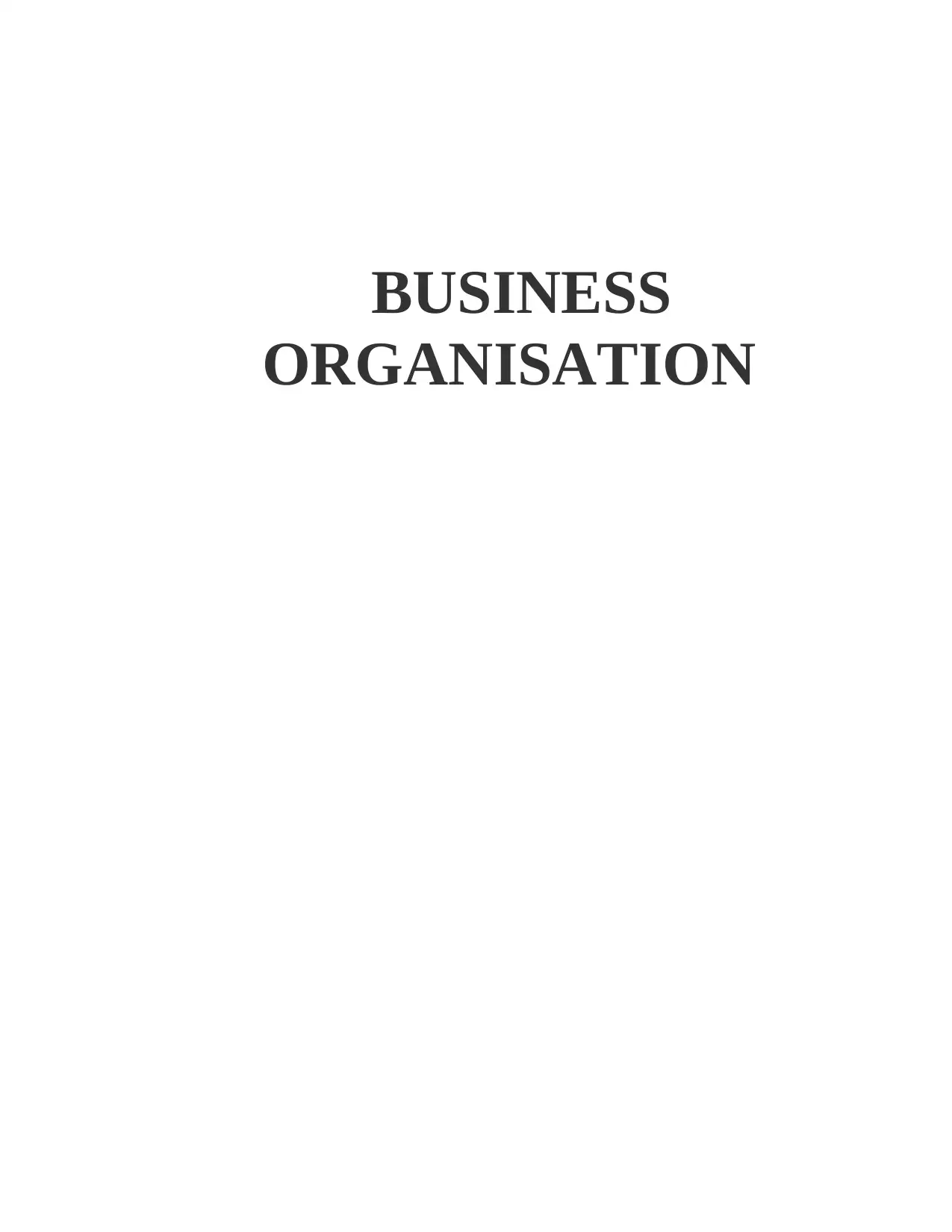
BUSINESS
ORGANISATION
ORGANISATION
Secure Best Marks with AI Grader
Need help grading? Try our AI Grader for instant feedback on your assignments.

Table of Contents
INTRODUCTION...........................................................................................................................1
Background information on Tesla Motors: ................................................................................1
Background of Netherlands.........................................................................................................2
ANALYTICAL APPROACHES................................................................................................5
DATA/DIAGRAMS/REPORTS.................................................................................................8
CONCLUSION..............................................................................................................................11
.......................................................................................................................................................11
REFERENCES..............................................................................................................................12
INTRODUCTION...........................................................................................................................1
Background information on Tesla Motors: ................................................................................1
Background of Netherlands.........................................................................................................2
ANALYTICAL APPROACHES................................................................................................5
DATA/DIAGRAMS/REPORTS.................................................................................................8
CONCLUSION..............................................................................................................................11
.......................................................................................................................................................11
REFERENCES..............................................................................................................................12
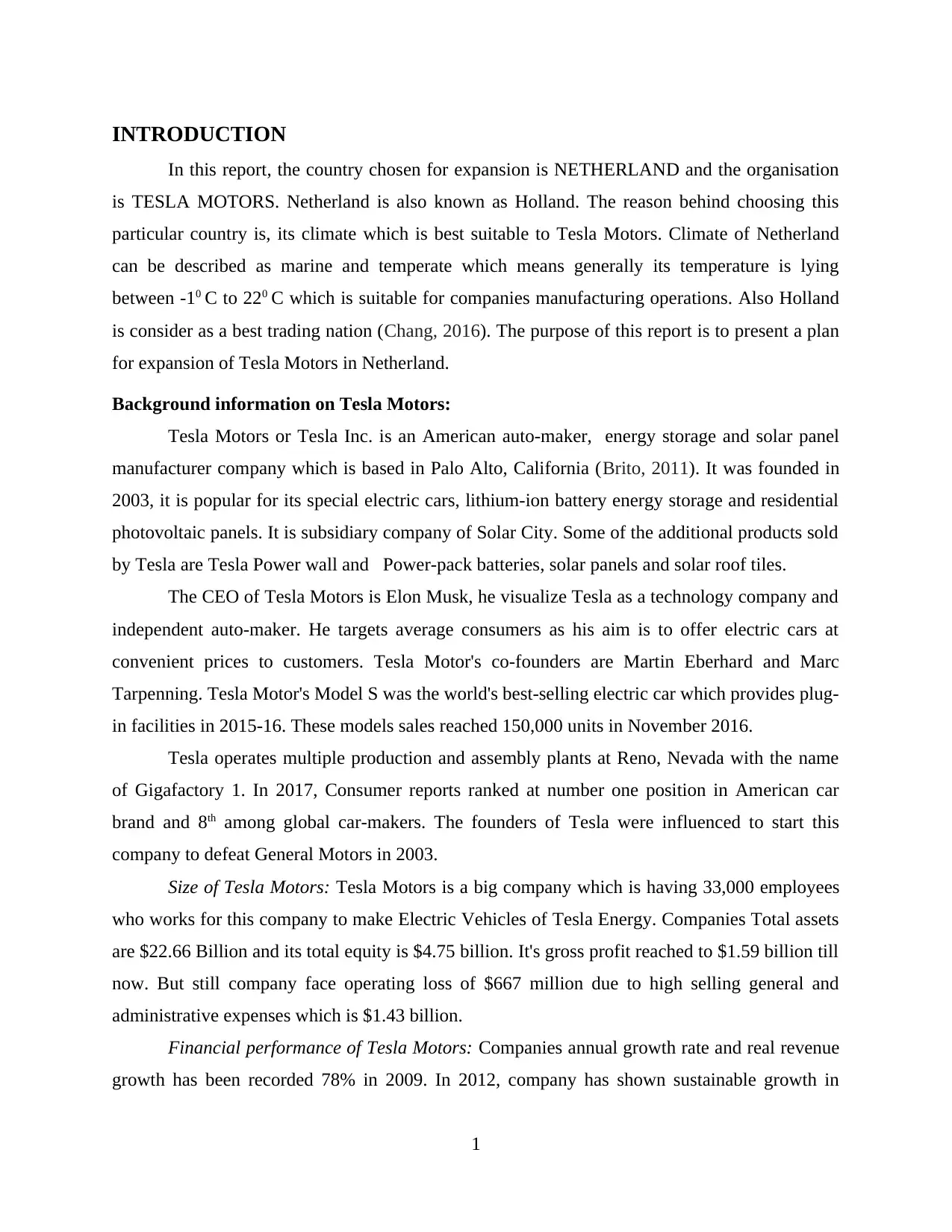
INTRODUCTION
In this report, the country chosen for expansion is NETHERLAND and the organisation
is TESLA MOTORS. Netherland is also known as Holland. The reason behind choosing this
particular country is, its climate which is best suitable to Tesla Motors. Climate of Netherland
can be described as marine and temperate which means generally its temperature is lying
between -10 C to 220 C which is suitable for companies manufacturing operations. Also Holland
is consider as a best trading nation (Chang, 2016). The purpose of this report is to present a plan
for expansion of Tesla Motors in Netherland.
Background information on Tesla Motors:
Tesla Motors or Tesla Inc. is an American auto-maker, energy storage and solar panel
manufacturer company which is based in Palo Alto, California (Brito, 2011). It was founded in
2003, it is popular for its special electric cars, lithium-ion battery energy storage and residential
photovoltaic panels. It is subsidiary company of Solar City. Some of the additional products sold
by Tesla are Tesla Power wall and Power-pack batteries, solar panels and solar roof tiles.
The CEO of Tesla Motors is Elon Musk, he visualize Tesla as a technology company and
independent auto-maker. He targets average consumers as his aim is to offer electric cars at
convenient prices to customers. Tesla Motor's co-founders are Martin Eberhard and Marc
Tarpenning. Tesla Motor's Model S was the world's best-selling electric car which provides plug-
in facilities in 2015-16. These models sales reached 150,000 units in November 2016.
Tesla operates multiple production and assembly plants at Reno, Nevada with the name
of Gigafactory 1. In 2017, Consumer reports ranked at number one position in American car
brand and 8th among global car-makers. The founders of Tesla were influenced to start this
company to defeat General Motors in 2003.
Size of Tesla Motors: Tesla Motors is a big company which is having 33,000 employees
who works for this company to make Electric Vehicles of Tesla Energy. Companies Total assets
are $22.66 Billion and its total equity is $4.75 billion. It's gross profit reached to $1.59 billion till
now. But still company face operating loss of $667 million due to high selling general and
administrative expenses which is $1.43 billion.
Financial performance of Tesla Motors: Companies annual growth rate and real revenue
growth has been recorded 78% in 2009. In 2012, company has shown sustainable growth in
1
In this report, the country chosen for expansion is NETHERLAND and the organisation
is TESLA MOTORS. Netherland is also known as Holland. The reason behind choosing this
particular country is, its climate which is best suitable to Tesla Motors. Climate of Netherland
can be described as marine and temperate which means generally its temperature is lying
between -10 C to 220 C which is suitable for companies manufacturing operations. Also Holland
is consider as a best trading nation (Chang, 2016). The purpose of this report is to present a plan
for expansion of Tesla Motors in Netherland.
Background information on Tesla Motors:
Tesla Motors or Tesla Inc. is an American auto-maker, energy storage and solar panel
manufacturer company which is based in Palo Alto, California (Brito, 2011). It was founded in
2003, it is popular for its special electric cars, lithium-ion battery energy storage and residential
photovoltaic panels. It is subsidiary company of Solar City. Some of the additional products sold
by Tesla are Tesla Power wall and Power-pack batteries, solar panels and solar roof tiles.
The CEO of Tesla Motors is Elon Musk, he visualize Tesla as a technology company and
independent auto-maker. He targets average consumers as his aim is to offer electric cars at
convenient prices to customers. Tesla Motor's co-founders are Martin Eberhard and Marc
Tarpenning. Tesla Motor's Model S was the world's best-selling electric car which provides plug-
in facilities in 2015-16. These models sales reached 150,000 units in November 2016.
Tesla operates multiple production and assembly plants at Reno, Nevada with the name
of Gigafactory 1. In 2017, Consumer reports ranked at number one position in American car
brand and 8th among global car-makers. The founders of Tesla were influenced to start this
company to defeat General Motors in 2003.
Size of Tesla Motors: Tesla Motors is a big company which is having 33,000 employees
who works for this company to make Electric Vehicles of Tesla Energy. Companies Total assets
are $22.66 Billion and its total equity is $4.75 billion. It's gross profit reached to $1.59 billion till
now. But still company face operating loss of $667 million due to high selling general and
administrative expenses which is $1.43 billion.
Financial performance of Tesla Motors: Companies annual growth rate and real revenue
growth has been recorded 78% in 2009. In 2012, company has shown sustainable growth in
1
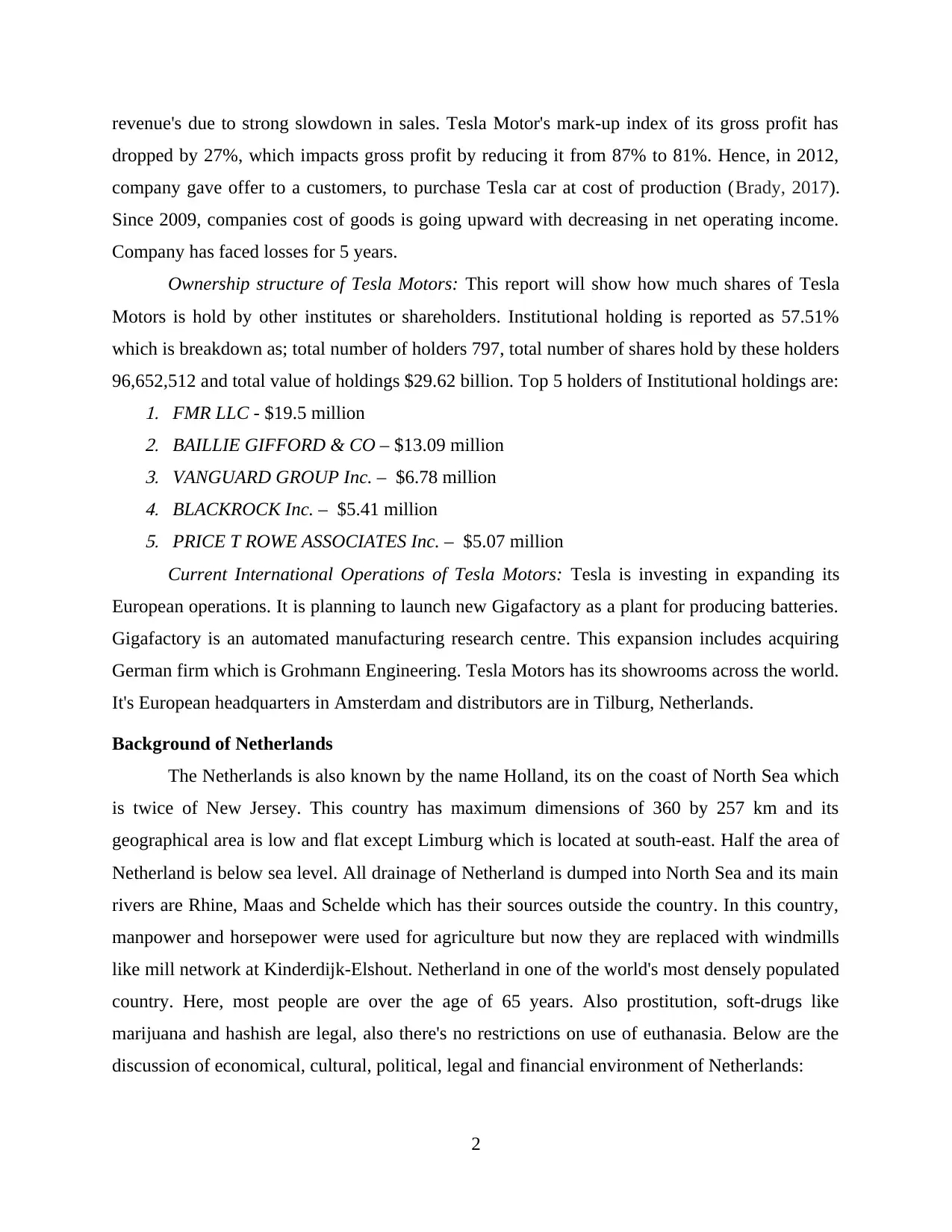
revenue's due to strong slowdown in sales. Tesla Motor's mark-up index of its gross profit has
dropped by 27%, which impacts gross profit by reducing it from 87% to 81%. Hence, in 2012,
company gave offer to a customers, to purchase Tesla car at cost of production (Brady, 2017).
Since 2009, companies cost of goods is going upward with decreasing in net operating income.
Company has faced losses for 5 years.
Ownership structure of Tesla Motors: This report will show how much shares of Tesla
Motors is hold by other institutes or shareholders. Institutional holding is reported as 57.51%
which is breakdown as; total number of holders 797, total number of shares hold by these holders
96,652,512 and total value of holdings $29.62 billion. Top 5 holders of Institutional holdings are:1. FMR LLC - $19.5 million2. BAILLIE GIFFORD & CO – $13.09 million3. VANGUARD GROUP Inc. – $6.78 million4. BLACKROCK Inc. – $5.41 million5. PRICE T ROWE ASSOCIATES Inc. – $5.07 million
Current International Operations of Tesla Motors: Tesla is investing in expanding its
European operations. It is planning to launch new Gigafactory as a plant for producing batteries.
Gigafactory is an automated manufacturing research centre. This expansion includes acquiring
German firm which is Grohmann Engineering. Tesla Motors has its showrooms across the world.
It's European headquarters in Amsterdam and distributors are in Tilburg, Netherlands.
Background of Netherlands
The Netherlands is also known by the name Holland, its on the coast of North Sea which
is twice of New Jersey. This country has maximum dimensions of 360 by 257 km and its
geographical area is low and flat except Limburg which is located at south-east. Half the area of
Netherland is below sea level. All drainage of Netherland is dumped into North Sea and its main
rivers are Rhine, Maas and Schelde which has their sources outside the country. In this country,
manpower and horsepower were used for agriculture but now they are replaced with windmills
like mill network at Kinderdijk-Elshout. Netherland in one of the world's most densely populated
country. Here, most people are over the age of 65 years. Also prostitution, soft-drugs like
marijuana and hashish are legal, also there's no restrictions on use of euthanasia. Below are the
discussion of economical, cultural, political, legal and financial environment of Netherlands:
2
dropped by 27%, which impacts gross profit by reducing it from 87% to 81%. Hence, in 2012,
company gave offer to a customers, to purchase Tesla car at cost of production (Brady, 2017).
Since 2009, companies cost of goods is going upward with decreasing in net operating income.
Company has faced losses for 5 years.
Ownership structure of Tesla Motors: This report will show how much shares of Tesla
Motors is hold by other institutes or shareholders. Institutional holding is reported as 57.51%
which is breakdown as; total number of holders 797, total number of shares hold by these holders
96,652,512 and total value of holdings $29.62 billion. Top 5 holders of Institutional holdings are:1. FMR LLC - $19.5 million2. BAILLIE GIFFORD & CO – $13.09 million3. VANGUARD GROUP Inc. – $6.78 million4. BLACKROCK Inc. – $5.41 million5. PRICE T ROWE ASSOCIATES Inc. – $5.07 million
Current International Operations of Tesla Motors: Tesla is investing in expanding its
European operations. It is planning to launch new Gigafactory as a plant for producing batteries.
Gigafactory is an automated manufacturing research centre. This expansion includes acquiring
German firm which is Grohmann Engineering. Tesla Motors has its showrooms across the world.
It's European headquarters in Amsterdam and distributors are in Tilburg, Netherlands.
Background of Netherlands
The Netherlands is also known by the name Holland, its on the coast of North Sea which
is twice of New Jersey. This country has maximum dimensions of 360 by 257 km and its
geographical area is low and flat except Limburg which is located at south-east. Half the area of
Netherland is below sea level. All drainage of Netherland is dumped into North Sea and its main
rivers are Rhine, Maas and Schelde which has their sources outside the country. In this country,
manpower and horsepower were used for agriculture but now they are replaced with windmills
like mill network at Kinderdijk-Elshout. Netherland in one of the world's most densely populated
country. Here, most people are over the age of 65 years. Also prostitution, soft-drugs like
marijuana and hashish are legal, also there's no restrictions on use of euthanasia. Below are the
discussion of economical, cultural, political, legal and financial environment of Netherlands:
2
Secure Best Marks with AI Grader
Need help grading? Try our AI Grader for instant feedback on your assignments.
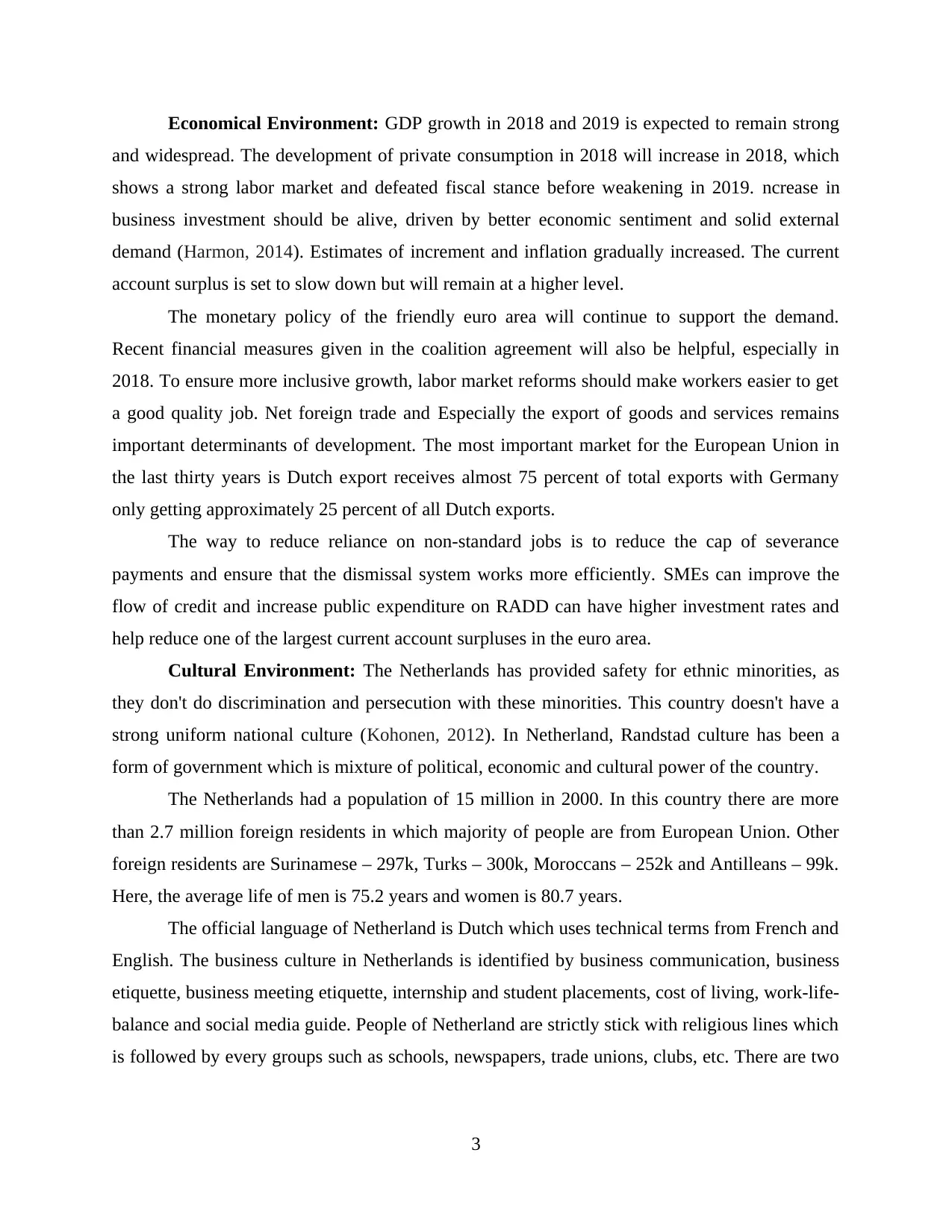
Economical Environment: GDP growth in 2018 and 2019 is expected to remain strong
and widespread. The development of private consumption in 2018 will increase in 2018, which
shows a strong labor market and defeated fiscal stance before weakening in 2019. ncrease in
business investment should be alive, driven by better economic sentiment and solid external
demand (Harmon, 2014). Estimates of increment and inflation gradually increased. The current
account surplus is set to slow down but will remain at a higher level.
The monetary policy of the friendly euro area will continue to support the demand.
Recent financial measures given in the coalition agreement will also be helpful, especially in
2018. To ensure more inclusive growth, labor market reforms should make workers easier to get
a good quality job. Net foreign trade and Especially the export of goods and services remains
important determinants of development. The most important market for the European Union in
the last thirty years is Dutch export receives almost 75 percent of total exports with Germany
only getting approximately 25 percent of all Dutch exports.
The way to reduce reliance on non-standard jobs is to reduce the cap of severance
payments and ensure that the dismissal system works more efficiently. SMEs can improve the
flow of credit and increase public expenditure on RADD can have higher investment rates and
help reduce one of the largest current account surpluses in the euro area.
Cultural Environment: The Netherlands has provided safety for ethnic minorities, as
they don't do discrimination and persecution with these minorities. This country doesn't have a
strong uniform national culture (Kohonen, 2012). In Netherland, Randstad culture has been a
form of government which is mixture of political, economic and cultural power of the country.
The Netherlands had a population of 15 million in 2000. In this country there are more
than 2.7 million foreign residents in which majority of people are from European Union. Other
foreign residents are Surinamese – 297k, Turks – 300k, Moroccans – 252k and Antilleans – 99k.
Here, the average life of men is 75.2 years and women is 80.7 years.
The official language of Netherland is Dutch which uses technical terms from French and
English. The business culture in Netherlands is identified by business communication, business
etiquette, business meeting etiquette, internship and student placements, cost of living, work-life-
balance and social media guide. People of Netherland are strictly stick with religious lines which
is followed by every groups such as schools, newspapers, trade unions, clubs, etc. There are two
3
and widespread. The development of private consumption in 2018 will increase in 2018, which
shows a strong labor market and defeated fiscal stance before weakening in 2019. ncrease in
business investment should be alive, driven by better economic sentiment and solid external
demand (Harmon, 2014). Estimates of increment and inflation gradually increased. The current
account surplus is set to slow down but will remain at a higher level.
The monetary policy of the friendly euro area will continue to support the demand.
Recent financial measures given in the coalition agreement will also be helpful, especially in
2018. To ensure more inclusive growth, labor market reforms should make workers easier to get
a good quality job. Net foreign trade and Especially the export of goods and services remains
important determinants of development. The most important market for the European Union in
the last thirty years is Dutch export receives almost 75 percent of total exports with Germany
only getting approximately 25 percent of all Dutch exports.
The way to reduce reliance on non-standard jobs is to reduce the cap of severance
payments and ensure that the dismissal system works more efficiently. SMEs can improve the
flow of credit and increase public expenditure on RADD can have higher investment rates and
help reduce one of the largest current account surpluses in the euro area.
Cultural Environment: The Netherlands has provided safety for ethnic minorities, as
they don't do discrimination and persecution with these minorities. This country doesn't have a
strong uniform national culture (Kohonen, 2012). In Netherland, Randstad culture has been a
form of government which is mixture of political, economic and cultural power of the country.
The Netherlands had a population of 15 million in 2000. In this country there are more
than 2.7 million foreign residents in which majority of people are from European Union. Other
foreign residents are Surinamese – 297k, Turks – 300k, Moroccans – 252k and Antilleans – 99k.
Here, the average life of men is 75.2 years and women is 80.7 years.
The official language of Netherland is Dutch which uses technical terms from French and
English. The business culture in Netherlands is identified by business communication, business
etiquette, business meeting etiquette, internship and student placements, cost of living, work-life-
balance and social media guide. People of Netherland are strictly stick with religious lines which
is followed by every groups such as schools, newspapers, trade unions, clubs, etc. There are two
3

large religious groups in Netherlands which are; Roman Catholic and Protestant. Minority group
such as Muslims, Jews and Hindus are also here.
There is a long tradition of negotiations in the Netherlands, which is in close and regular
contact between trade unions, employer organizations and the government (Kumarand Thapliyal,
2010). It is a member of all major international organizations.
Political Environment: The government of Netherland is constitutional monarchy.
Monarch is the head of state which is Queen Beatrix, but at present sovereign's power is replaced
by ceremonial. Prime minister is the chief of government. Queen appoints prime minister who is
leader of the majority party in parliament. Council of state ate the advisory committee of
Netherlands political system, who usually develops and coordinates policies, rules and
regulations. Council Members are appointed by Queen and Prime minister together. The term
States General is combination of legislative branch and parliament of the nation.
The government of Netherlands does not play a major role in nation's economy.
Economic ventures and private businesses are also not own by the government of Netherlands.
Private sectors here, controls telecommunications and public transport services. Government
utilises 46% of nations GDP on public spending like infrastructure projects, social spending,
education and health cares. But this portion of GDP has declined over the decades.
The impact of Netherland government can be seen on 3 different levels which are: First level: At this level, government restricts and regulates the permits for certain types
of businesses and controls product safety and advertising. Second level: At this level, government takes an active step to manage nations credit
supply and currency values. Here, government tries to reduce the affect of Inflation in
economy. Netherland government also tries to make value of currency low to get
competitive advantage across the world through selling cheap Dutch products.
Third level: In this final level, government takes an active role in managing environment
of the nation. Here, it takes steps to cut the pollution by 80 percent. Government also
takes necessary steps to manage land, as maximum geographical area of Netherland is
under sea level and prone to the risk of flooding. This step also includes identifying types
of structures which is possible to built on different piece of land.
One of the main objectives of Netherlands economic and foreign policy is to
integrate European economic and political together.
4
such as Muslims, Jews and Hindus are also here.
There is a long tradition of negotiations in the Netherlands, which is in close and regular
contact between trade unions, employer organizations and the government (Kumarand Thapliyal,
2010). It is a member of all major international organizations.
Political Environment: The government of Netherland is constitutional monarchy.
Monarch is the head of state which is Queen Beatrix, but at present sovereign's power is replaced
by ceremonial. Prime minister is the chief of government. Queen appoints prime minister who is
leader of the majority party in parliament. Council of state ate the advisory committee of
Netherlands political system, who usually develops and coordinates policies, rules and
regulations. Council Members are appointed by Queen and Prime minister together. The term
States General is combination of legislative branch and parliament of the nation.
The government of Netherlands does not play a major role in nation's economy.
Economic ventures and private businesses are also not own by the government of Netherlands.
Private sectors here, controls telecommunications and public transport services. Government
utilises 46% of nations GDP on public spending like infrastructure projects, social spending,
education and health cares. But this portion of GDP has declined over the decades.
The impact of Netherland government can be seen on 3 different levels which are: First level: At this level, government restricts and regulates the permits for certain types
of businesses and controls product safety and advertising. Second level: At this level, government takes an active step to manage nations credit
supply and currency values. Here, government tries to reduce the affect of Inflation in
economy. Netherland government also tries to make value of currency low to get
competitive advantage across the world through selling cheap Dutch products.
Third level: In this final level, government takes an active role in managing environment
of the nation. Here, it takes steps to cut the pollution by 80 percent. Government also
takes necessary steps to manage land, as maximum geographical area of Netherland is
under sea level and prone to the risk of flooding. This step also includes identifying types
of structures which is possible to built on different piece of land.
One of the main objectives of Netherlands economic and foreign policy is to
integrate European economic and political together.
4
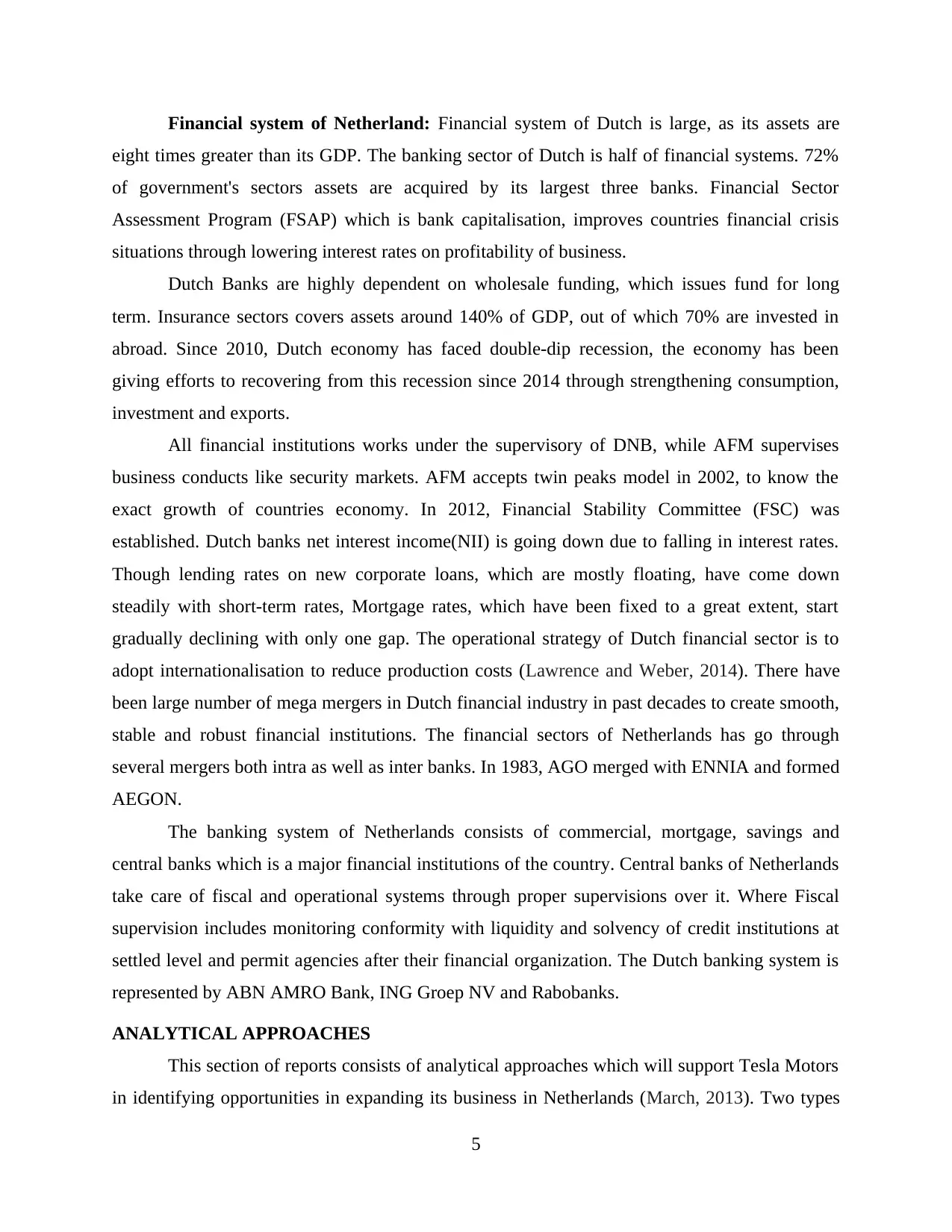
Financial system of Netherland: Financial system of Dutch is large, as its assets are
eight times greater than its GDP. The banking sector of Dutch is half of financial systems. 72%
of government's sectors assets are acquired by its largest three banks. Financial Sector
Assessment Program (FSAP) which is bank capitalisation, improves countries financial crisis
situations through lowering interest rates on profitability of business.
Dutch Banks are highly dependent on wholesale funding, which issues fund for long
term. Insurance sectors covers assets around 140% of GDP, out of which 70% are invested in
abroad. Since 2010, Dutch economy has faced double-dip recession, the economy has been
giving efforts to recovering from this recession since 2014 through strengthening consumption,
investment and exports.
All financial institutions works under the supervisory of DNB, while AFM supervises
business conducts like security markets. AFM accepts twin peaks model in 2002, to know the
exact growth of countries economy. In 2012, Financial Stability Committee (FSC) was
established. Dutch banks net interest income(NII) is going down due to falling in interest rates.
Though lending rates on new corporate loans, which are mostly floating, have come down
steadily with short-term rates, Mortgage rates, which have been fixed to a great extent, start
gradually declining with only one gap. The operational strategy of Dutch financial sector is to
adopt internationalisation to reduce production costs (Lawrence and Weber, 2014). There have
been large number of mega mergers in Dutch financial industry in past decades to create smooth,
stable and robust financial institutions. The financial sectors of Netherlands has go through
several mergers both intra as well as inter banks. In 1983, AGO merged with ENNIA and formed
AEGON.
The banking system of Netherlands consists of commercial, mortgage, savings and
central banks which is a major financial institutions of the country. Central banks of Netherlands
take care of fiscal and operational systems through proper supervisions over it. Where Fiscal
supervision includes monitoring conformity with liquidity and solvency of credit institutions at
settled level and permit agencies after their financial organization. The Dutch banking system is
represented by ABN AMRO Bank, ING Groep NV and Rabobanks.
ANALYTICAL APPROACHES
This section of reports consists of analytical approaches which will support Tesla Motors
in identifying opportunities in expanding its business in Netherlands (March, 2013). Two types
5
eight times greater than its GDP. The banking sector of Dutch is half of financial systems. 72%
of government's sectors assets are acquired by its largest three banks. Financial Sector
Assessment Program (FSAP) which is bank capitalisation, improves countries financial crisis
situations through lowering interest rates on profitability of business.
Dutch Banks are highly dependent on wholesale funding, which issues fund for long
term. Insurance sectors covers assets around 140% of GDP, out of which 70% are invested in
abroad. Since 2010, Dutch economy has faced double-dip recession, the economy has been
giving efforts to recovering from this recession since 2014 through strengthening consumption,
investment and exports.
All financial institutions works under the supervisory of DNB, while AFM supervises
business conducts like security markets. AFM accepts twin peaks model in 2002, to know the
exact growth of countries economy. In 2012, Financial Stability Committee (FSC) was
established. Dutch banks net interest income(NII) is going down due to falling in interest rates.
Though lending rates on new corporate loans, which are mostly floating, have come down
steadily with short-term rates, Mortgage rates, which have been fixed to a great extent, start
gradually declining with only one gap. The operational strategy of Dutch financial sector is to
adopt internationalisation to reduce production costs (Lawrence and Weber, 2014). There have
been large number of mega mergers in Dutch financial industry in past decades to create smooth,
stable and robust financial institutions. The financial sectors of Netherlands has go through
several mergers both intra as well as inter banks. In 1983, AGO merged with ENNIA and formed
AEGON.
The banking system of Netherlands consists of commercial, mortgage, savings and
central banks which is a major financial institutions of the country. Central banks of Netherlands
take care of fiscal and operational systems through proper supervisions over it. Where Fiscal
supervision includes monitoring conformity with liquidity and solvency of credit institutions at
settled level and permit agencies after their financial organization. The Dutch banking system is
represented by ABN AMRO Bank, ING Groep NV and Rabobanks.
ANALYTICAL APPROACHES
This section of reports consists of analytical approaches which will support Tesla Motors
in identifying opportunities in expanding its business in Netherlands (March, 2013). Two types
5
Paraphrase This Document
Need a fresh take? Get an instant paraphrase of this document with our AI Paraphraser
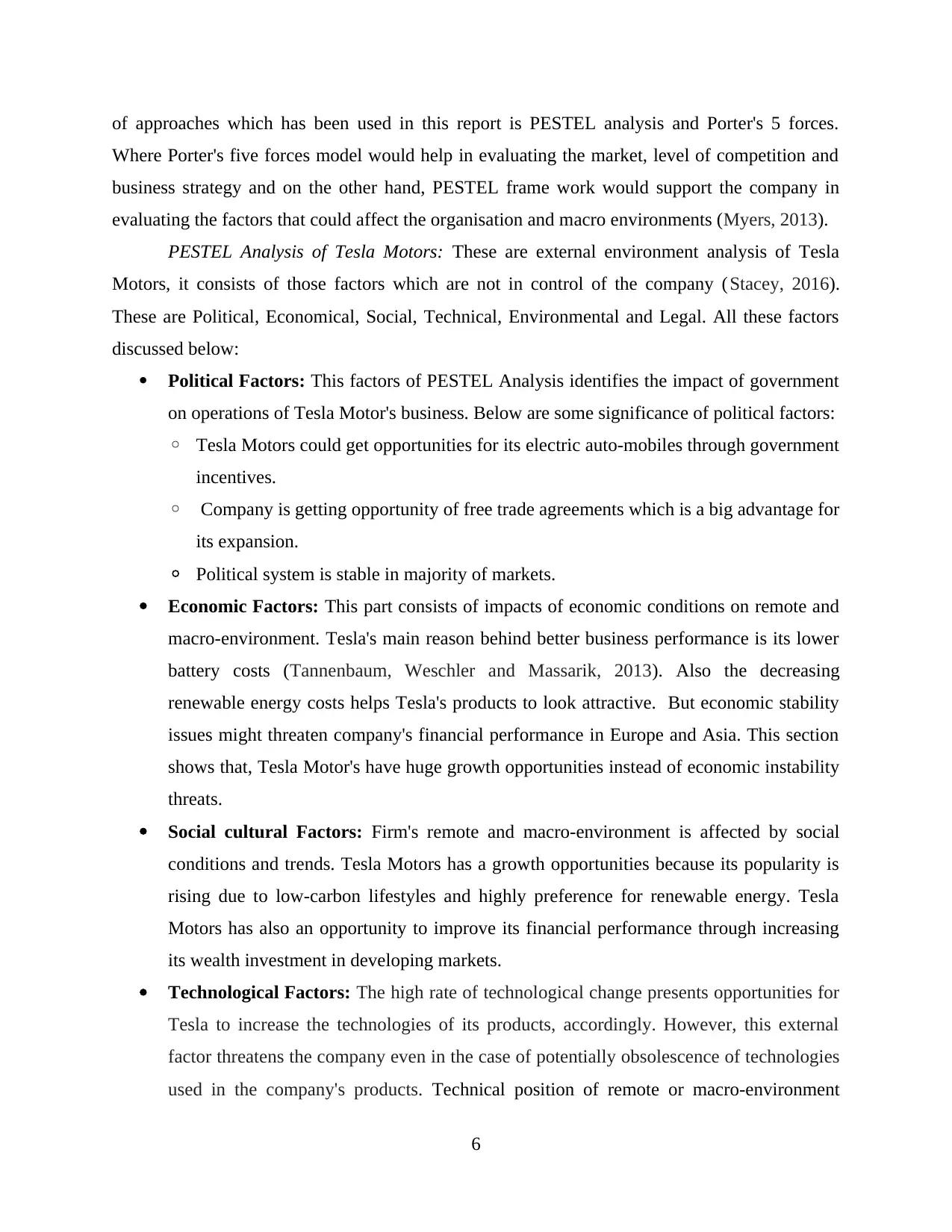
of approaches which has been used in this report is PESTEL analysis and Porter's 5 forces.
Where Porter's five forces model would help in evaluating the market, level of competition and
business strategy and on the other hand, PESTEL frame work would support the company in
evaluating the factors that could affect the organisation and macro environments (Myers, 2013).
PESTEL Analysis of Tesla Motors: These are external environment analysis of Tesla
Motors, it consists of those factors which are not in control of the company (Stacey, 2016).
These are Political, Economical, Social, Technical, Environmental and Legal. All these factors
discussed below:
Political Factors: This factors of PESTEL Analysis identifies the impact of government
on operations of Tesla Motor's business. Below are some significance of political factors:
◦ Tesla Motors could get opportunities for its electric auto-mobiles through government
incentives.
◦ Company is getting opportunity of free trade agreements which is a big advantage for
its expansion.
◦ Political system is stable in majority of markets.
Economic Factors: This part consists of impacts of economic conditions on remote and
macro-environment. Tesla's main reason behind better business performance is its lower
battery costs (Tannenbaum, Weschler and Massarik, 2013). Also the decreasing
renewable energy costs helps Tesla's products to look attractive. But economic stability
issues might threaten company's financial performance in Europe and Asia. This section
shows that, Tesla Motor's have huge growth opportunities instead of economic instability
threats.
Social cultural Factors: Firm's remote and macro-environment is affected by social
conditions and trends. Tesla Motors has a growth opportunities because its popularity is
rising due to low-carbon lifestyles and highly preference for renewable energy. Tesla
Motors has also an opportunity to improve its financial performance through increasing
its wealth investment in developing markets.
Technological Factors: The high rate of technological change presents opportunities for
Tesla to increase the technologies of its products, accordingly. However, this external
factor threatens the company even in the case of potentially obsolescence of technologies
used in the company's products. Technical position of remote or macro-environment
6
Where Porter's five forces model would help in evaluating the market, level of competition and
business strategy and on the other hand, PESTEL frame work would support the company in
evaluating the factors that could affect the organisation and macro environments (Myers, 2013).
PESTEL Analysis of Tesla Motors: These are external environment analysis of Tesla
Motors, it consists of those factors which are not in control of the company (Stacey, 2016).
These are Political, Economical, Social, Technical, Environmental and Legal. All these factors
discussed below:
Political Factors: This factors of PESTEL Analysis identifies the impact of government
on operations of Tesla Motor's business. Below are some significance of political factors:
◦ Tesla Motors could get opportunities for its electric auto-mobiles through government
incentives.
◦ Company is getting opportunity of free trade agreements which is a big advantage for
its expansion.
◦ Political system is stable in majority of markets.
Economic Factors: This part consists of impacts of economic conditions on remote and
macro-environment. Tesla's main reason behind better business performance is its lower
battery costs (Tannenbaum, Weschler and Massarik, 2013). Also the decreasing
renewable energy costs helps Tesla's products to look attractive. But economic stability
issues might threaten company's financial performance in Europe and Asia. This section
shows that, Tesla Motor's have huge growth opportunities instead of economic instability
threats.
Social cultural Factors: Firm's remote and macro-environment is affected by social
conditions and trends. Tesla Motors has a growth opportunities because its popularity is
rising due to low-carbon lifestyles and highly preference for renewable energy. Tesla
Motors has also an opportunity to improve its financial performance through increasing
its wealth investment in developing markets.
Technological Factors: The high rate of technological change presents opportunities for
Tesla to increase the technologies of its products, accordingly. However, this external
factor threatens the company even in the case of potentially obsolescence of technologies
used in the company's products. Technical position of remote or macro-environment
6
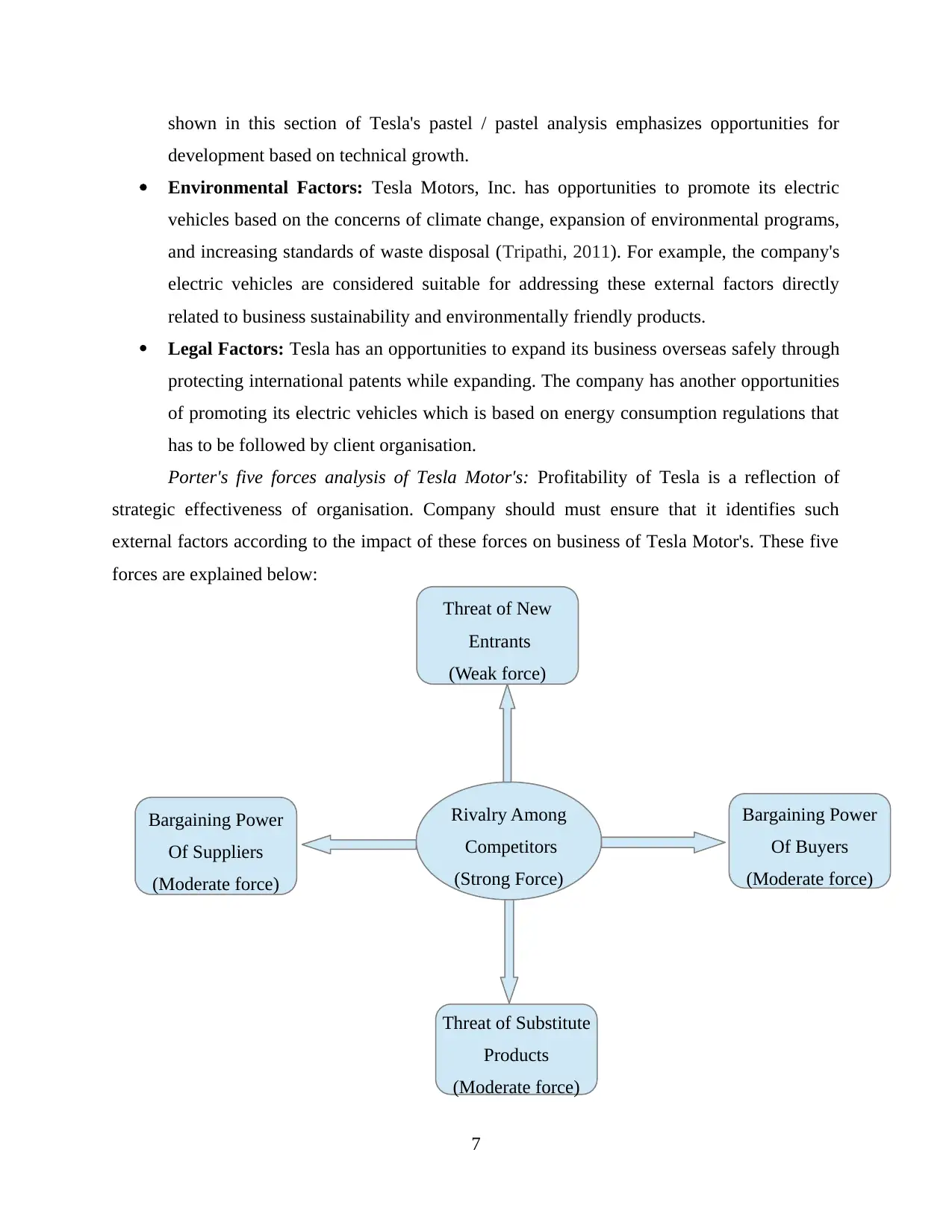
shown in this section of Tesla's pastel / pastel analysis emphasizes opportunities for
development based on technical growth.
Environmental Factors: Tesla Motors, Inc. has opportunities to promote its electric
vehicles based on the concerns of climate change, expansion of environmental programs,
and increasing standards of waste disposal (Tripathi, 2011). For example, the company's
electric vehicles are considered suitable for addressing these external factors directly
related to business sustainability and environmentally friendly products.
Legal Factors: Tesla has an opportunities to expand its business overseas safely through
protecting international patents while expanding. The company has another opportunities
of promoting its electric vehicles which is based on energy consumption regulations that
has to be followed by client organisation.
Porter's five forces analysis of Tesla Motor's: Profitability of Tesla is a reflection of
strategic effectiveness of organisation. Company should must ensure that it identifies such
external factors according to the impact of these forces on business of Tesla Motor's. These five
forces are explained below:
7
Threat of New
Entrants
(Weak force)
Rivalry Among
Competitors
(Strong Force)
Bargaining Power
Of Suppliers
(Moderate force)
Bargaining Power
Of Buyers
(Moderate force)
Threat of Substitute
Products
(Moderate force)
development based on technical growth.
Environmental Factors: Tesla Motors, Inc. has opportunities to promote its electric
vehicles based on the concerns of climate change, expansion of environmental programs,
and increasing standards of waste disposal (Tripathi, 2011). For example, the company's
electric vehicles are considered suitable for addressing these external factors directly
related to business sustainability and environmentally friendly products.
Legal Factors: Tesla has an opportunities to expand its business overseas safely through
protecting international patents while expanding. The company has another opportunities
of promoting its electric vehicles which is based on energy consumption regulations that
has to be followed by client organisation.
Porter's five forces analysis of Tesla Motor's: Profitability of Tesla is a reflection of
strategic effectiveness of organisation. Company should must ensure that it identifies such
external factors according to the impact of these forces on business of Tesla Motor's. These five
forces are explained below:
7
Threat of New
Entrants
(Weak force)
Rivalry Among
Competitors
(Strong Force)
Bargaining Power
Of Suppliers
(Moderate force)
Bargaining Power
Of Buyers
(Moderate force)
Threat of Substitute
Products
(Moderate force)
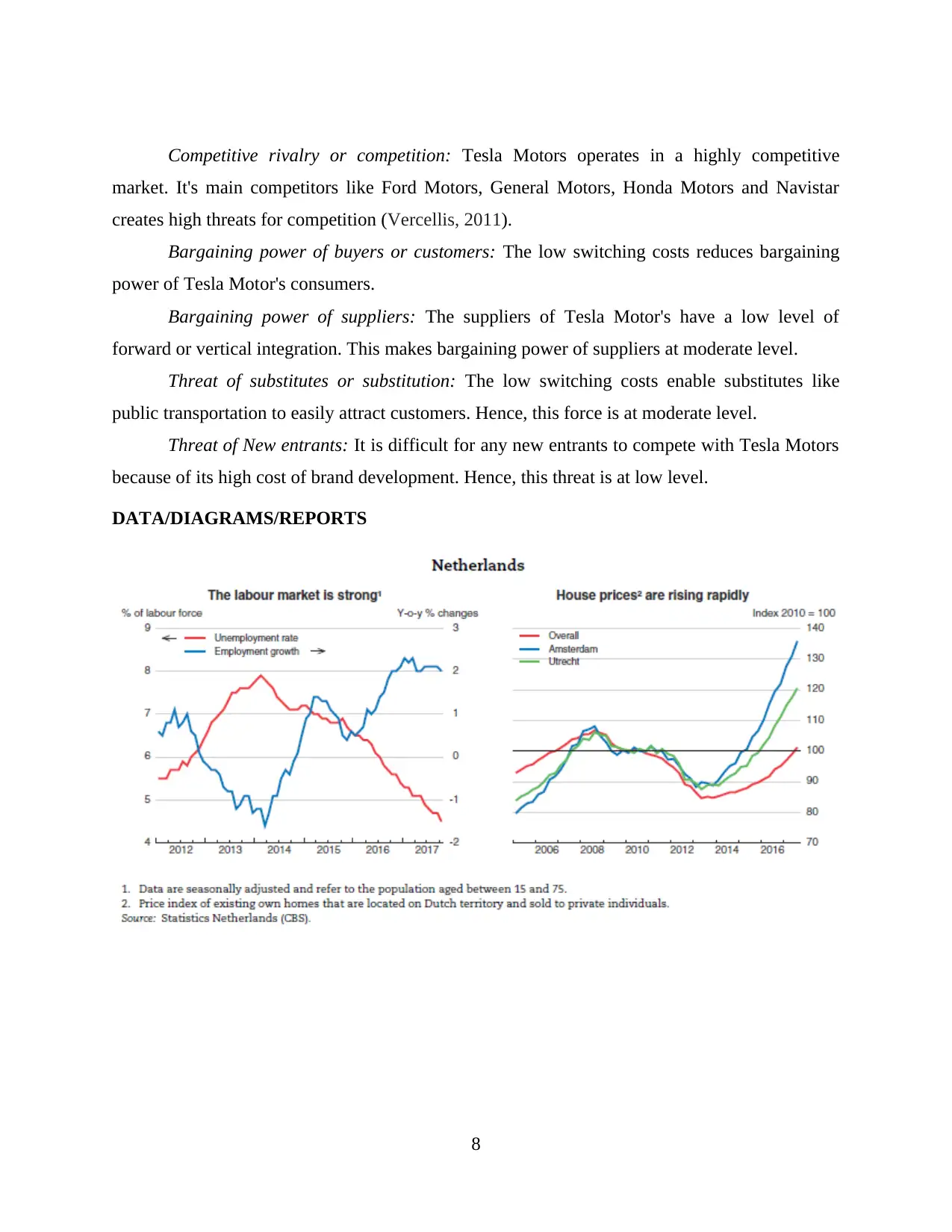
Competitive rivalry or competition: Tesla Motors operates in a highly competitive
market. It's main competitors like Ford Motors, General Motors, Honda Motors and Navistar
creates high threats for competition (Vercellis, 2011).
Bargaining power of buyers or customers: The low switching costs reduces bargaining
power of Tesla Motor's consumers.
Bargaining power of suppliers: The suppliers of Tesla Motor's have a low level of
forward or vertical integration. This makes bargaining power of suppliers at moderate level.
Threat of substitutes or substitution: The low switching costs enable substitutes like
public transportation to easily attract customers. Hence, this force is at moderate level.
Threat of New entrants: It is difficult for any new entrants to compete with Tesla Motors
because of its high cost of brand development. Hence, this threat is at low level.
DATA/DIAGRAMS/REPORTS
8
market. It's main competitors like Ford Motors, General Motors, Honda Motors and Navistar
creates high threats for competition (Vercellis, 2011).
Bargaining power of buyers or customers: The low switching costs reduces bargaining
power of Tesla Motor's consumers.
Bargaining power of suppliers: The suppliers of Tesla Motor's have a low level of
forward or vertical integration. This makes bargaining power of suppliers at moderate level.
Threat of substitutes or substitution: The low switching costs enable substitutes like
public transportation to easily attract customers. Hence, this force is at moderate level.
Threat of New entrants: It is difficult for any new entrants to compete with Tesla Motors
because of its high cost of brand development. Hence, this threat is at low level.
DATA/DIAGRAMS/REPORTS
8
Secure Best Marks with AI Grader
Need help grading? Try our AI Grader for instant feedback on your assignments.
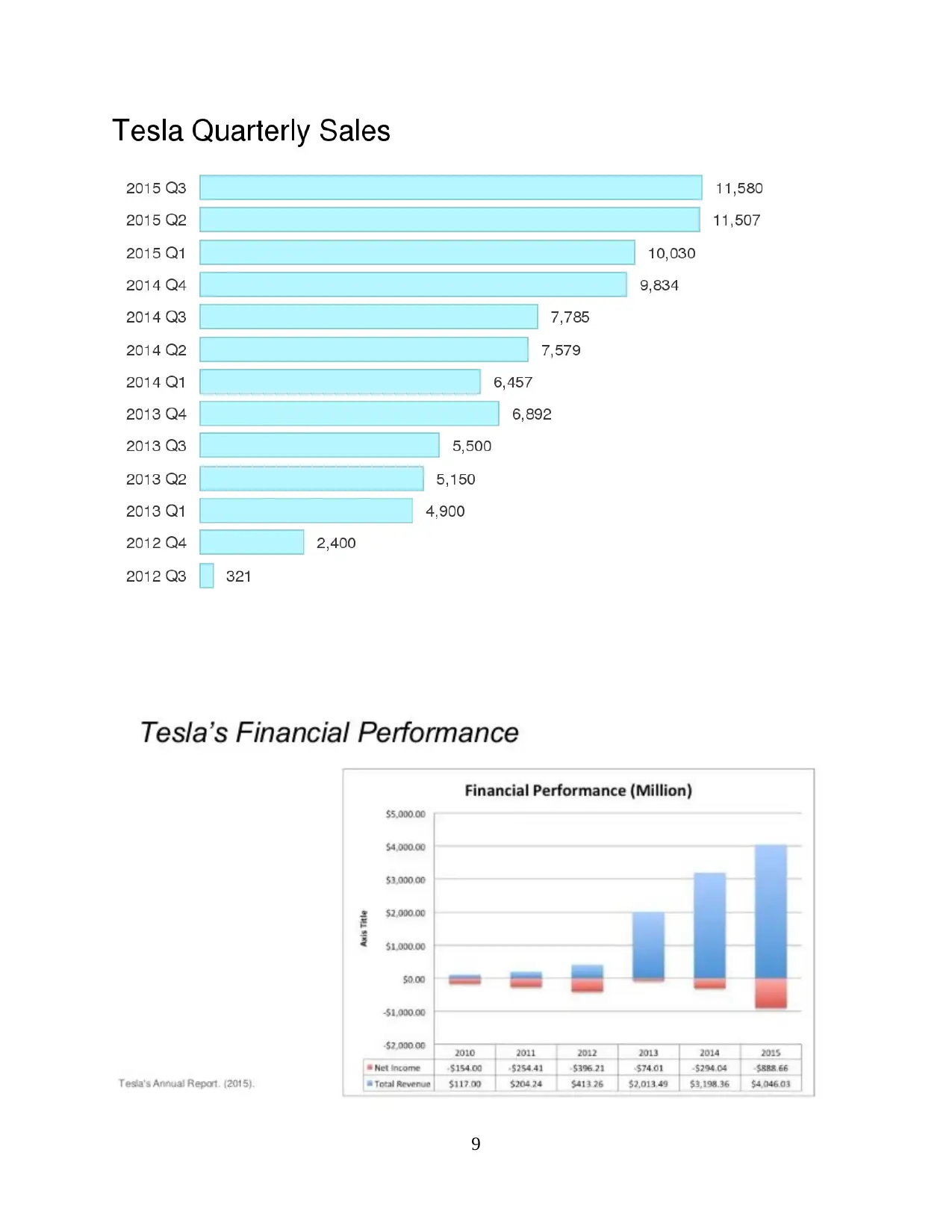
9
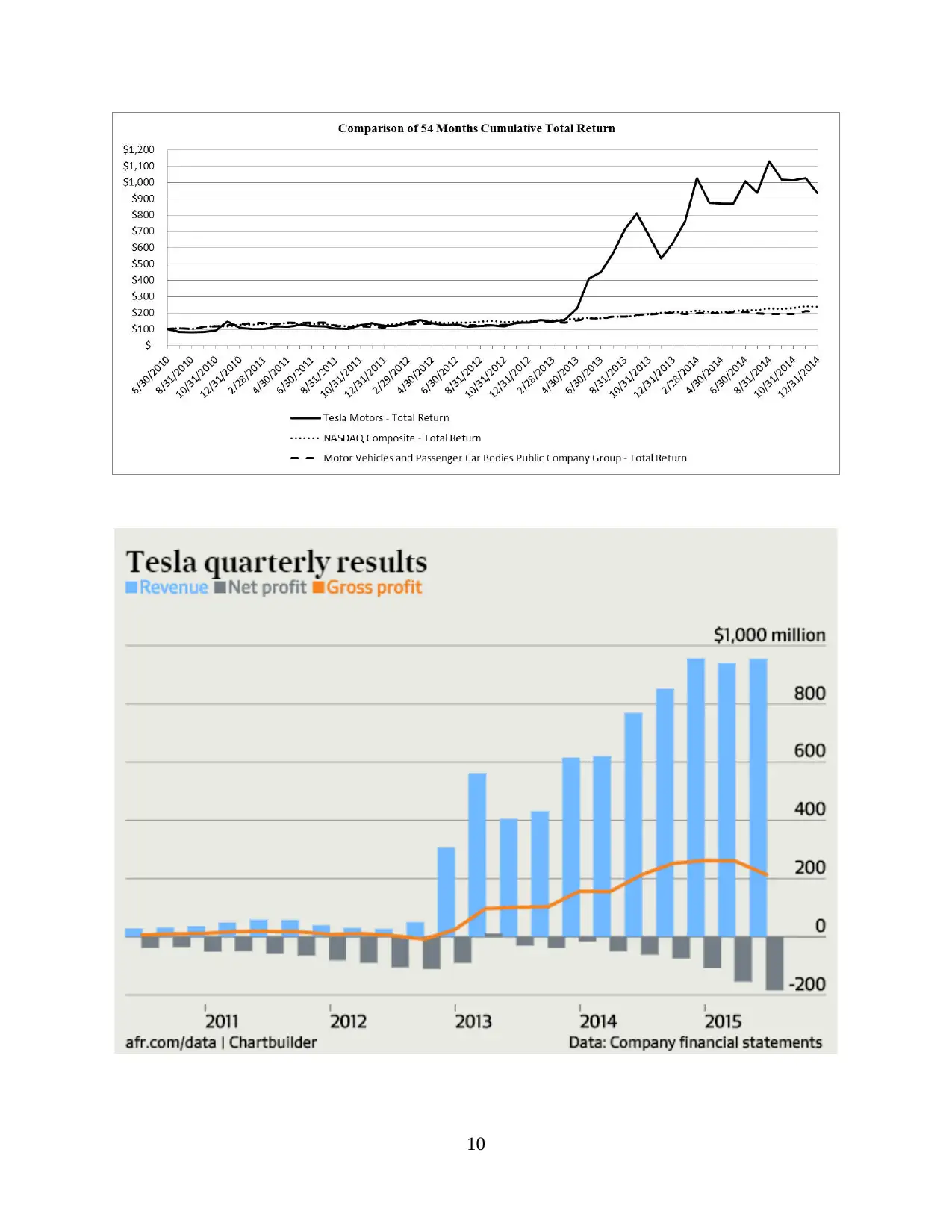
10

CONCLUSION
The results of Tesla Motors, Inc.'s Five Force and PESTEL analysis show that
competition is the most important force affecting business. Thus, the company should give
priority to this force in formulating this strategy. Its recommendation is to continue to strengthen
its competitiveness for Tesla's strong competitive advantage can be achieved through innovation
and increased market presence. For example, in the context of innovation, Tesla could increase
its R & D investment to cross the rivals' innovation rate.
11
The results of Tesla Motors, Inc.'s Five Force and PESTEL analysis show that
competition is the most important force affecting business. Thus, the company should give
priority to this force in formulating this strategy. Its recommendation is to continue to strengthen
its competitiveness for Tesla's strong competitive advantage can be achieved through innovation
and increased market presence. For example, in the context of innovation, Tesla could increase
its R & D investment to cross the rivals' innovation rate.
11
Paraphrase This Document
Need a fresh take? Get an instant paraphrase of this document with our AI Paraphraser
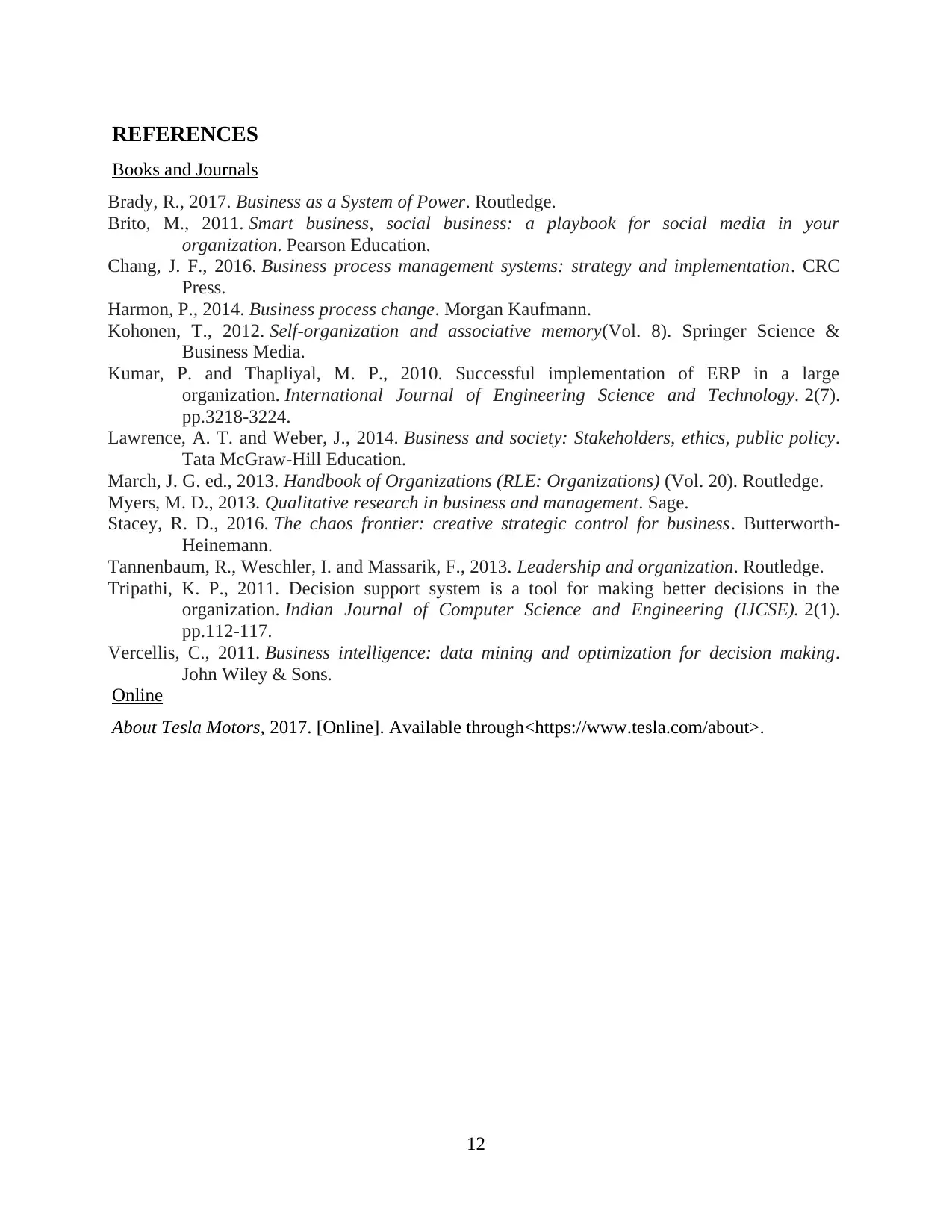
REFERENCES
Books and Journals
Brady, R., 2017. Business as a System of Power. Routledge.
Brito, M., 2011. Smart business, social business: a playbook for social media in your
organization. Pearson Education.
Chang, J. F., 2016. Business process management systems: strategy and implementation. CRC
Press.
Harmon, P., 2014. Business process change. Morgan Kaufmann.
Kohonen, T., 2012. Self-organization and associative memory(Vol. 8). Springer Science &
Business Media.
Kumar, P. and Thapliyal, M. P., 2010. Successful implementation of ERP in a large
organization. International Journal of Engineering Science and Technology. 2(7).
pp.3218-3224.
Lawrence, A. T. and Weber, J., 2014. Business and society: Stakeholders, ethics, public policy.
Tata McGraw-Hill Education.
March, J. G. ed., 2013. Handbook of Organizations (RLE: Organizations) (Vol. 20). Routledge.
Myers, M. D., 2013. Qualitative research in business and management. Sage.
Stacey, R. D., 2016. The chaos frontier: creative strategic control for business. Butterworth-
Heinemann.
Tannenbaum, R., Weschler, I. and Massarik, F., 2013. Leadership and organization. Routledge.
Tripathi, K. P., 2011. Decision support system is a tool for making better decisions in the
organization. Indian Journal of Computer Science and Engineering (IJCSE). 2(1).
pp.112-117.
Vercellis, C., 2011. Business intelligence: data mining and optimization for decision making.
John Wiley & Sons.
Online
About Tesla Motors, 2017. [Online]. Available through<https://www.tesla.com/about>.
12
Books and Journals
Brady, R., 2017. Business as a System of Power. Routledge.
Brito, M., 2011. Smart business, social business: a playbook for social media in your
organization. Pearson Education.
Chang, J. F., 2016. Business process management systems: strategy and implementation. CRC
Press.
Harmon, P., 2014. Business process change. Morgan Kaufmann.
Kohonen, T., 2012. Self-organization and associative memory(Vol. 8). Springer Science &
Business Media.
Kumar, P. and Thapliyal, M. P., 2010. Successful implementation of ERP in a large
organization. International Journal of Engineering Science and Technology. 2(7).
pp.3218-3224.
Lawrence, A. T. and Weber, J., 2014. Business and society: Stakeholders, ethics, public policy.
Tata McGraw-Hill Education.
March, J. G. ed., 2013. Handbook of Organizations (RLE: Organizations) (Vol. 20). Routledge.
Myers, M. D., 2013. Qualitative research in business and management. Sage.
Stacey, R. D., 2016. The chaos frontier: creative strategic control for business. Butterworth-
Heinemann.
Tannenbaum, R., Weschler, I. and Massarik, F., 2013. Leadership and organization. Routledge.
Tripathi, K. P., 2011. Decision support system is a tool for making better decisions in the
organization. Indian Journal of Computer Science and Engineering (IJCSE). 2(1).
pp.112-117.
Vercellis, C., 2011. Business intelligence: data mining and optimization for decision making.
John Wiley & Sons.
Online
About Tesla Motors, 2017. [Online]. Available through<https://www.tesla.com/about>.
12
1 out of 14
Related Documents
Your All-in-One AI-Powered Toolkit for Academic Success.
+13062052269
info@desklib.com
Available 24*7 on WhatsApp / Email
![[object Object]](/_next/static/media/star-bottom.7253800d.svg)
Unlock your academic potential
© 2024 | Zucol Services PVT LTD | All rights reserved.





